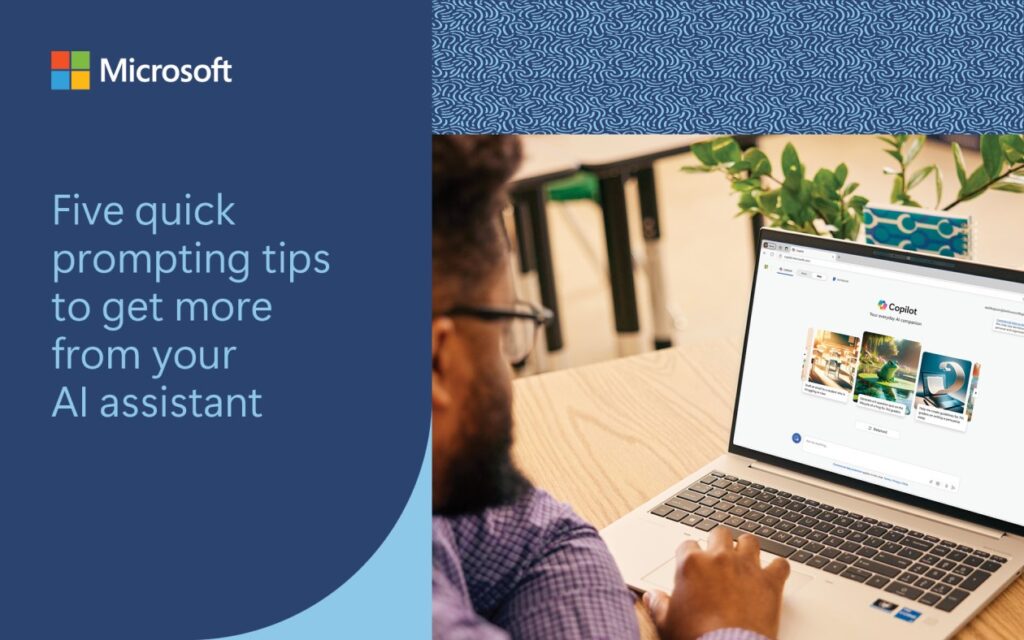Ever wonder why AI assistants sometimes miss the mark? Your AI assistant is only as good as your prompt. Great prompts are shortcuts to better results. Let’s explore how to write prompts that can turn your AI assistant into an efficient and powerful tool for education.
If you’re new to AI assistants and Microsoft Copilot, read more in Meet your AI assistant for education: Microsoft Copilot.
Elements of a good prompt
The Elements of a Good Prompt PDF in the Classroom toolkit: Unlocking generative AI safely and responsibly provides all the basics you need to start writing prompts effectively. These five key elements can be applied to any AI assistant. The more elements you incorporate, the better your results will match your query—saving time and limiting irrelevant results.

In addition to the elements of a good prompt here are five tips to getting better responses from your AI assistant.
1. Set the tone
When using AI assistants like Copilot, setting the tone is necessary to get the best results. Copilot offers you a choice between three conversation styles:
Microsoft Copilot, your AI assistant
Learn about Copilot- Creative: Perfect for unique story ideas, poems, artistic expressions, and brainstorming creative solutions.
- Balanced: A middle ground that excels in casual conversations, summarizing news or articles, and giving practical advice.
- Precise: Ideal for concise, factual responses like writing code snippets, defining terms, or answering specific questions.
Setting the tone will guide the AI tool in creating responses with the desired voice, saving you time and effort.
2. Give specific instructions
Good prompting requires providing details about what you need and the context around the request. Select the hyperlinks in the examples to see how Copilot delivers different content based on the instructions in the prompt.
The prompt “Create a lesson plan for an art class” lacks specific instruction and will likely result in a less helpful response.
The prompt “Create a comprehensive 7th grade lesson plan for an art class focused on telling a story through a collage. Include detailed objectives, materials needed, step-by-step instructions, classroom activities, and differentiation strategies for diverse learners. Provide background information on the artistic techniques and notable examples of storytelling through collage from art history“ offers details and instructions for the type of response needed.
Remember, the more information you provide your AI assistant in a prompt, the better it can return useful results. Prompting is an iterative process. Start with a prompt and then iterate and build on it to refine your results.
3. Tailor for a point of view or audience
Sharing more details about your audience can help your AI assistant deliver what you need quicker. Mentioning education demographics like age, grade level, subject, and personal interests can result in relevant, creative outputs that will engage your audience and enhance their understanding of a concept.
4. Specify length
Specify the length of the response you want from your AI assistant. Do you need key points in a bulleted list, a summary in a few sentences, or detailed paragraphs with a technical explanation? Setting this metric in your prompt will help you get results that are more ready-to-use and require less editing.
5. Specify format
Most AI assistants can format your results to suit your needs. Try requesting the results to be formatted in a table, a diagram, or an outline. Visit Microsoft Copilot resources for education and bookmark the How to write a prompt PDF for quick reference to all five of these tips.

Support your AI journey
At Microsoft Education, we want to ensure you have all the tools you need to succeed on your AI journey. No matter your experience level with AI tools, we’ve got you covered at every stage.
Boost your prompting skills
- Dig into what Copilot can help you do in your role with Microsoft Copilot resources for education.
- The Enhance teaching and learning with Microsoft Copilot training module on Microsoft Learn includes a unit on designing prompts for learning. Learn more tips on crafting prompts to help you fully leverage the power of Copilot.
- Embrace innovation with Prompt Lab for Minecraft Educators. This series of resources shows you how to use Copilot with Minecraft Education to create amazing learning experiences.
Elevate your AI literacy for teaching and learning
- Explore Smart learning: AI resources every educator should know for eleven curated resources to help educators like you boost their AI literacy.
- Use the Classroom Toolkit: Unlock generative AI safely and responsibly to help you start important conversations about responsible AI practices, including content fabrications, privacy considerations, bias awareness, and mental well-being.
The more you practice prompting, the easier it will be to get helpful results from AI assistants like Copilot. By learning to refine your prompts and build on them, you’ll save time and get more precise results. Dive in, experiment, and see how AI assistants can give you time and energy back to focus on what matters most.










